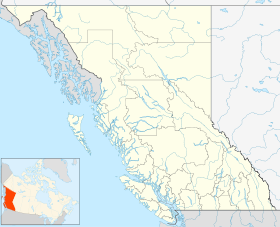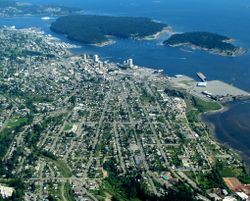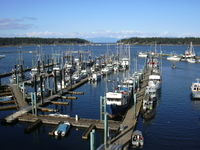Nanaimo
| City of Nanaimo | |||
|---|---|---|---|
|
|
|||
|
|||
| Nickname(s): THE HUB | |||
 City of Nanaimo
|
|||
| Coordinates: | |||
| Country | Canada | ||
| Province | British Columbia | ||
| Regional District | Nanaimo | ||
| Incorporated | 1874[1] | ||
| Government | |||
| - Mayor | John Ruttan | ||
| - Governing body | Nanaimo City Council | ||
| - MPs | Jean Crowder James Lunney |
||
| - MLAs | Leonard Krog Ron Cantelon Doug Routley |
||
| Area | |||
| - City | 89.30 km2 (34.5 sq mi) | ||
| Elevation | 28 m (92 ft) | ||
| Population (2006) | |||
| - City | 78,692 (ranked 62nd) | ||
| - Density | 881.2/km2 (2,282.3/sq mi) | ||
| - Metro | 92,361 (ranked 38th) | ||
| - Metro density | 72.2/km2 (187/sq mi) | ||
| Time zone | PST (UTC−8) | ||
| - Summer (DST) | PDT (UTC−7) | ||
| Postal code span | V9R to V9V | ||
| Area code(s) | +1-250 | ||
| Website | City of Nanaimo | ||
|
|
|||
Nanaimo (pronounced /nəˈnaɪmoʊ/) (Canada 2006 Census population 78,692) is the second largest city on Vancouver Island in British Columbia, Canada. It has been dubbed the "Bathtub Racing Capital of the World" and "Harbour City". Nanaimo is also sometimes referred to as the "Hub City" because of its central location on Vancouver Island and due to the layout of the downtown streets which form a "hub" pattern. It is also fondly known as the "Hub, Tub, and Pub City" because of its association with the bathtub racing and the numerous "watering holes" in Old Nanaimo. It is the seat of the Regional District of Nanaimo.
Contents |
History
The first Europeans to find Nanaimo Bay were those of the 1791 Spanish voyage of Juan Carrasco, under the command of Francisco de Eliza. They gave it the name Bocas de Winthuysen.
Nanaimo began as a trading post in the early 1800s; in 1849 the Snuneymuxw chief Ki-et-sa-kun ("Coal Tyee") informed the Hudson's Bay Company of the presence of coal in the area, and in 1853 the company built a fort known as the Nanaimo Bastion (still preserved). Subsequently the town was chiefly known for the export of coal.
Robert Dunsmuir helped establish coal mines in the Nanaimo harbour area as an employee of the Hudson's Bay Company, and later mined in Nanaimo as one of the first independent miners. In 1869 Dunmuir discovered coal several miles North of Nanaimo at Wellington, and subsequently created the company Dunsmuir and Diggle Ltd so he could acquire crown land and finance the startup of what became the Wellington Colliery. With the success of Dunsmuir and Diggle and the Wellington Colliery, Dunsmuir expanded his operations to include steam railways. Dunsmuir sold Wellington Coal through its Departure Bay docks, while competing Nanaimo coal was sold by the Vancouver Coal Company through the Nanaimo docks.
The 1887 Nanaimo Mine Explosion killed 150 miners and was the largest man-made explosion until the Halifax Explosion. In the 1940s, lumber supplanted coal as the main business although Minetown Days are still celebrated in the neighbouring community of Lantzville.[2].
Location and geography

Located on Vancouver Island, Nanaimo is about 110 km northwest of Victoria, and 55 km west of Vancouver, separated by the Strait of Georgia, but directly linked to Vancouver via BC Ferries. By virtue of its proximity to Vancouver, Nanaimo is the gateway to many other destinations both on the island — Tofino, Comox Valley, Campbell River, Port Alberni, Rathtrevor Beach Provincial Park — and off its coast — Newcastle Island, Protection Island, Gabriola Island, Valdes Island, and many other of the Gulf Islands. Nanaimo has often been referred to as 'A mall in search of a city' due to the malls that stretch from the south to the north.
Climate
| Climate data for Nanaimo | |||||||||||||
|---|---|---|---|---|---|---|---|---|---|---|---|---|---|
| Month | Jan | Feb | Mar | Apr | May | Jun | Jul | Aug | Sep | Oct | Nov | Dec | Year |
| Source: Environment Canada[3] | |||||||||||||
Transportation
Nanaimo is served by three airports: Nanaimo Airport with services to Vancouver, Nanaimo Harbour Water Airport with services to Vancouver harbour, and Nanaimo/Long Lake Water Airport. Nanaimo also has three BC Ferry terminals located at Departure Bay, Duke Point, and downtown. The downtown terminal services Gabriola Island while Departure Bay and Duke Point service Horseshoe Bay and Tsawwassen respectively. There is also regular passenger train service south to Victoria and north to Courtenay along the E and N Railway.
Highways 1, 19 and 19A traverse the city. Bus service in the city is provided by Nanaimo Regional Transit.
Demographics
Nanaimo had a population of 78,692 people in 2006, which was an increase of 7.8% from the 2001 census count. The median household income in 2005 for Nanaimo was $45,937, which is below the British Columbia provincial average of $52,709.[4]
Economy

The original economic driver was coal mining; however, the forestry industry supplanted it in the early 1960s with the building of the MacMillan Bloedel pulp mill Harmac in 1958, named after Harvey MacMillan. Today the pulp mill is owned by the employees and local investors and injects well over half a million dollars a day into the local economy . The largest employer is the provincial government with NCO Group call centre a close second. The service, retail and tourism industries are also big contributors to the local economy.
A recent surge of higher-density real estate development, centred in the Old City/Downtown area, as well as construction of a city-funded waterfront conference centre, have proven controversial. Proponents of these developments argue that they will bolster the city's economy, while critics worry that they will block waterfront views and increase traffic congestion. Concerns have also been raised about the waterfront conference centre's construction running over its proposed budget. The current council is working hard to solve homeless issues, and has established a strong relationship with the provincial government to provide several hundred low-income housing spaces. Nanaimo has also been experiencing job growth in the technology sector.
Media outlets

Nanaimo is served by three newspapers - the Canwest-owned Nanaimo Daily News with about 10,500 copies six days a week and the Harbour City Star with nearly 40,000 copies twice a week, as well as the Black Press-owned Nanaimo News Bulletin (35,000 copies three times a week). Nanaimo also hosts a bureau for CIVI-TV (A Victoria, cable channel 12) and a satellite office for CHEK-TV (Independent, cable channel 6).
Nanaimo is also served by the Jim Pattison Group's CHWF-FM and CKWV-FM, as well as CHLY-FM, an independent community campus radio station. CBC Radio One is heard over CBU from Vancouver, but with no local content for Nanaimo itself.
Politics
In the Canadian House of Commons, Nanaimo is represented by the ridings of Nanaimo—Cowichan (Jean Crowder, New Democratic Party) and Nanaimo—Alberni (James Lunney, Conservative). In the Legislative Assembly of British Columbia, Nanaimo is represented by the ridings of Nanaimo (Leonard Krog, British Columbia New Democratic Party) and Nanaimo-Parksville (Ron Cantelon, British Columbia Liberal Party). The mayor of Nanaimo is currently John Ruttan, who was preceded by Gary Korpan. The most colourful and famous mayor Nanaimo ever had was Frank J. Ney, who instigated Nanaimo's well-known bathtub races, which he regularly attended dressed as a pirate. There is a statue to commemorate Ney - dressed in his pirate costume - and the bathtub races at Swy-a-Lana Lagoon, which is on the Nanaimo waterfront; Ney was also an MLA for the Social Credit party while he was also mayor. An elementary school has been named in his honour.
Open Government
The city's planning department has, over the past five years, steadily produced enough municipal data to warrant a Time magazine article on open-government, and been dubbed 'the capital of Google Earth'.[5] Working directly with Google, the city fed it a wealth of information about its buildings, property lines, utilities and streets. The result is earth.nanaimo.ca, a wealth of city data viewed through the Google Earth 3D mapping program. http://www.nanaimo.ca/datafeeds/
Education
Nanaimo has over 30 elementary and secondary schools, most of which are public and are operated by School District 68 Nanaimo-Ladysmith.
The main campus of Vancouver Island University is located in Nanaimo, which brings many international students to the city. The school is also renowned for its music programs, such as its jazz program. Its MBA Program also attracts many international students from all over the world.
Sports
- Nanaimo is home to the Canadian Junior Football League's Vancouver Island Raiders, who play at Caledonia Park.
- Nanaimo is home to the British Columbia Hockey League's Nanaimo Clippers and to the Western Lacrosse Association's Nanaimo Timbermen, both of which play at the Frank Crane Arena.
- The Nanaimo Pirates, of the B.C. Premier Baseball League (BCPBL), play at Serauxmen Stadium.
- The Nanaimo United, of the Vancouver Island Soccer League (VISL), play at Mearle Logan Turf Field in Beban Park.
- The Nanaimo BMX Association, sanctioned by the ABA - American Bicycle Association races at Beban Park.
- The Nanaimo Hornets RFC home ground is at Pioneer Park.
- The city also is home to The Nanaimo Riptides Swim Team, That Practice at the Nanaimo Aquatic Center (NAC)
- The Nanaimo Rowing Club of Nanaimo practices on Long Lake
- There is also a synchronized swimming team The Nanaimo Diamonds
Notable residents
- Cameron Bright, child actor
- Justin Chatwin, actor
- Jimmy Claxton, Black baseball pitcher who broke the U.S. baseball color line
- Raymond Collishaw, one of the highest scoring British Aces of WWI, ranking overall third in the British Empire with 60 confirmed kills.
- Allison Crowe, singer/songwriter and pianist
- John DeSantis, actor
- David Essig, songwriter, musician, producer
- Jodelle Ferland, child actress
- David Gogo, blues guitarist
- Gogo, keyboardist for the rock band Trooper
- Diana Krall, jazz pianist and vocalist
- Tim Lander, poet
- Cory Monteith, actor
- Rick Scott, children's performer and musician
- Shane Sutcliffe, boxer
- Kirsten Sweetland, triathlete
Kim Catrall, Actress
References
- ↑ "Nanaimo Municipal Hall". City of Nanaimo. http://www.nanaimo.ca/EN/main/municipal.html?zoom_highlight=incorporated. Retrieved 2009-04-04.
- ↑ Nanaimo Info - History
- ↑ Environment Canada—Canadian Climate Normals 1971–2000, accessed 10 July 2009
- ↑ "Nanaimo, British Columbia - Detailed City Profile". http://census2006.ca/census-recensement/2006/dp-pd/prof/92-591/details/page.cfm?Lang=E&Geo1=CSD&Code1=5921007&Geo2=PR&Code2=48&Data=Count&SearchText=Nanaimo&SearchType=Begins&SearchPR=01&B1=All&Custom=. Retrieved 2009-10-15.
- ↑ "Postcard from Nanaimo How Google Earth Ate Our Town". Time. 2008-03-10. http://www.time.com/time/world/article/0,8599,1720932,00.html. Retrieved 2009-08-27.
External links
|
|||||
|
|||||||||||||||||

